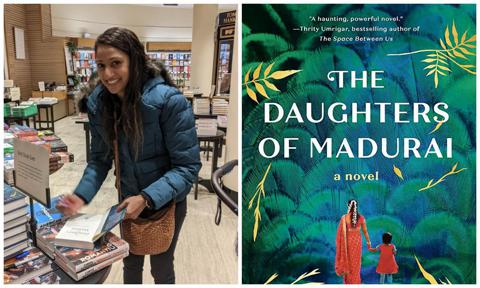
In The Daughters Of Madurai, a fascinating fictional narrative based on reality, debutante author Rajasree Variyar takes us through the small town to delve deep into the world of female infanticide and a rigid caste system that can wreak havoc with women’s lives. We dissect how she explores these subjects with a new-age perspective…
HELLO!: You were born in Bengaluru, grew up in Australia and now live in London. How is your understanding of Indian traditions so strong?
Rajasree Variyar: “I have my family to thank for that! My parents were determined to ensure that my younger sister and I maintained a strong connect to our culture. I was raised a practising Hindu, with all the richness of the stories of the religion. My parents spoke Malayalam at home; my mother always cooked traditional Keralite food; and we were part of Indian-Australian community organisations. My parents and I also travelled back to India at least every two years, to spend over a month with my family in Kerala, Chennai and Hyderabad.”
H!: What’s your connection with Madurai?
RV: “Some of my father’s uncles moved to Madurai in the 1970s; they established an Ayurvedic hospital in the city. So I have extended family there. In parallel, my research into female infanticide led me to discover that the practice was rampant in several taluks around Madurai, including Usilampatti. Madurai itself is a beautiful, ancient city with a complex history. Those strangely serendipitous facts made it a great setting for the novel.
H!: You’ve explored the relevant yet oft-overlooked theme of female infanticide in India. What made you focus on this subject?
RV: “When I was around nine or 10 years old, I came across a segment on the murder of a baby girl in Bengaluru, while my parents were watching the evening news. Writing a novel about female infanticide gave me the opportunity to delve into the issue, to try to make sense of a practice I find incomprehensible.”
H!: How differently (or not) are things done in your desi household?
RV: “I’m one of two daughters. My parents moved to Australia to provide us with as many opportunities as possible. Nevertheless, I felt the weight of expectations that were driven by my gender. There was a clear delineation by gender over household chores — an expectation that the women in the family would cook, clean and maintain the premises. But I never felt as though I couldn’t challenge these traditional views or restrictions in other parts of my life.”
H!: Kamala Amma’s cameo in the novel is very moving. Though there may be opposing views to the message reinforced through her life — that women will have tough lives should they choose to stay single...
RV: “Kamala Amma is one of my favourite characters, so I love to hear that she has had an impact. The message I want to convey here is that marriage and motherhood should not be seen as the only path a woman’s life can take, that women who choose not to marry can be vilified by their communities, and that this should change.”
H!: Janani, the main protagonist, is a resilient woman. But her narrative is a little unreal. Were you just letting your creative juices flow?
RV: “I won’t deny that Janani’s story is not the norm due to the structure of Indian society. But relationships between differing socio-economic classes and castes are increasing among the younger generation, which is great to see. I chose to write from the viewpoint that “highly unlikely” does not mean “impossible!” How that unfolds in the novel certainly relies on a little creativity.”
H!: The book offers a new-age message of acceptance, given how the couple embraces Nila’s reality. How evolved are Indian parents in Australia?
RV: “It all depends on the parents! I know of parents who have refused to accept inter-religious marriages, and of ones who haven’t batted an eye at their gay or non-binary child. I think there’s a span of views from traditional to more liberal among the Indian-Australia community.
H!: Sydney is a vibrant city. How similar is your life from Nila’s in the book?
RV: “I drew quite heavily from my life in Sydney for Nila’s life. I worked in the Central Business District in Sydney and absolutely love the beauty of both downtown Sydney and the suburbs, where I grew up. The snippets of Sydney life in the novel are a small homage to the city.”
H!: You also work in insurance product development in London. What does a usual day in your life look like?
RV: “I try to write early in the morning before work. I also try to read as much as possible. I’m a long-distance runner and really enjoy interval training. My routine recently changed, as I now have a four-month-old daughter! I’m on maternity leave, and I snatch writing time when she naps.”
- Quick links
- Rajasree Variyar
- Books
- author






